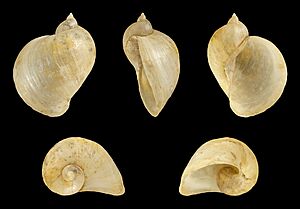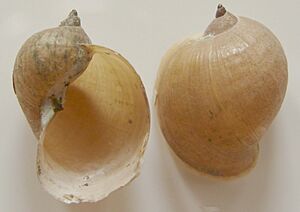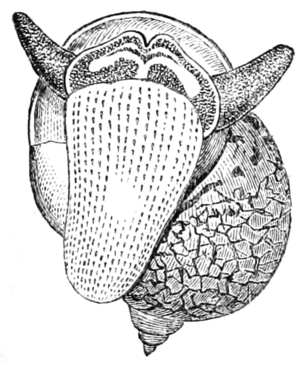Big-ear radix facts for kids
Quick facts for kids Big-ear radix |
|
|---|---|
 |
|
| A shell of Radix auricularia | |
| Conservation status | |
| Scientific classification | |
| Synonyms | |
|
The big-ear radix (scientific name: Radix auricularia) is a type of medium-sized freshwater snail. It's an aquatic animal that breathes air, belonging to a group called gastropods. Gastropods are a kind of mollusk, which also includes clams and octopuses. This snail is part of the Lymnaeidae family.
Radix auricularia is the main species that gives its name to the Radix group of snails.
Contents
What Does the Shell Look Like?
The shell of the big-ear radix is thin and shaped like a round egg. It's very puffy, with the largest part making up 90% of its total size.
The top part of the shell, called the spire, is short and wide. It narrows quickly at the very tip, known as the apex.
The shell has 4 to 5 whorls, which are the spiraling turns. These whorls are smooth, rounded, and grow quickly. Deep lines, called sutures, separate each whorl. The surface of the shell is shiny. It has fine, wavy growth lines, and sometimes a thicker line showing where the snail rested.
The shell can be yellow, beige, or tan in color.
The Ear-Shaped Opening
The snail's opening, called the aperture, looks like an ear. It's about five times taller than the spire. This opening is very large and oval-shaped. It takes up about four-fifths of the shell's total length.
The edge of the opening is thin and sharp. Inside, there's a twisted column called the columella. The snail's shell does not have an operculum, which is a lid that some snails use to close their shell.
The umbilicus (a small hole near the center of the shell) can be wide or covered. Usually, it's narrow and deep, almost closed. The shell's outer layer sometimes has alternating light and dark lines.
How Big Do They Get?
Adult Radix auricularia snails can grow up to 30 millimeters (about 1.2 inches) tall and 25 millimeters (about 1 inch) wide. However, most snails in a group are usually about half that size.
The shell's width is typically between 12 and 18 millimeters. Its height ranges from 14 to 24 millimeters. The shell of Radix auricularia is usually more than 0.75 times as wide as it is long.
What Does the Snail's Body Look Like?
The snail's body has small white spots on the back of its head and on its tentacles. However, its foot, which it uses to move, does not have these spots. The mantle, a soft layer of tissue, has a line of dark spots along its edge. These spots can sometimes be seen through the shell.
The foot is rounded and long, measuring about 18 by 11 millimeters. The head is wide and has ear-like flaps. The snail's tentacles are large, flat, and shaped like a fan or triangle. They are wider than they are tall.
The snail's blood contains blue hemocyanin, a substance that carries oxygen. Its heart beats slowly and steadily, about 34 times per minute. These snails move in a slow and careful way.
Where Do They Live?
Native Homes
Radix auricularia is originally from Europe and much of the Palearctic region. This includes places like Oman, Tibet, and Vietnam.
In Europe, you can find them in:
- Croatia
- Finland
- Germany
- Sweden
- Great Britain and Ireland
- Netherlands
- Poland
- Czech Republic
- Slovakia
In Asia, they live across the eastern Palearctic and in:
- Oman
- Vietnam (especially northern Vietnam)
New Homes Around the World
Radix auricularia has also been introduced to new places, meaning it was brought there by humans. It is now found in the United States and New Zealand.
In the Mid-Atlantic Region of the U.S., it lives in the Charles River in Massachusetts. It's also in Cayuga Lake and the Hudson River in New York State. You can find it in various ponds in New Jersey, New York, and Pennsylvania, and in Lake Champlain in Vermont.
In the Great Lakes Region, the first record of this snail in North America was before 1869 in the Hudson River. It was later found in Lake Michigan in 1901, and then in Lake Erie and Lake Ontario. It has also been reported in Lake Huron.
These snails can adapt to new environments. For example, in Lake Baikal, Russia, they used to only live in shallow areas. But recently, they have moved to rocky, deeper parts of the lake. The snails in these new habitats have stronger shells and feet. This helps them hold on better in the wavy water.
How Do They Live? (Ecology)
Where They Like to Live
This snail lives in freshwater lakes, ponds, and slow-moving rivers. They prefer places with muddy bottoms. Radix auricularia can live on rocks or plants in both calm and flowing water. They can even survive in places with very little oxygen. However, they usually prefer very still waters like lakes, bogs, or slow rivers where there is a silty bottom.
They have been found in water with a pH from 6.0 to 7.1. Their favorite temperature is around 19°C (66°F). However, this can change depending on the time of year and how much daylight there is. In Great Britain, they only live in hard water. They can also handle polluted water with lots of organic matter, sulfides, and bacteria.
What They Eat
Radix auricularia belongs to a family of snails that are "scrapers" and "collector-gatherers." This means they eat things like detritus (dead bits of plants and animals), Cladophora (a type of algae), and even sand grains.
Life Cycle and Reproduction
Like most snails that breathe air, Radix auricularia is a hermaphrodite. This means each snail has both male and female reproductive parts. They lay eggs every two years.
They lay their eggs in clumps, with each clump containing 50 to 150 eggs. The eggs develop faster when the water temperature increases from 10°C (50°F) upwards. However, the eggs cannot survive or develop if the water temperature reaches 36°C (97°F).
Snail and Parasites
Various snails in the Lymnaeidae family, including Radix auricularia, can carry many different kinds of trematodes. These are tiny worm-like parasites. One study found that about 80% of Radix auricularia snails near Wielkopolska National Park had trematodes.
Radix auricularia can be a host for many parasites. This means the parasites live inside the snail for part of their life. Some of these parasites include:
- Echinostoma revolutum
- Echinoparyphium recurvatum
- Hypoderaeum conoideum
- Clinostomum complanatum
- Apatemon gracilis
- Fasciola gigantica (a very important host for this one)
- Fasciola hepatica (in Oman)
- Notocotylus attenuatus
- Hymenolepis lanceolata (the snail is a paratenic host for this one, meaning it carries the parasite but the parasite doesn't develop further in the snail)
- Trichobilharzia franki
- Trichobilharzia ocellata
- Trichobilharzia szidati
- Mantoscyphidia radixi
- Orientobilharzia turkestanica
- Diplostomum spathaceum
- Paryphostomum radiatum
- Opisthioglyphe ranae
- Plagiorchis elegans
- Australapatemon burti
- Isthmiophora melis
- Tylodelphis clavata
Some of these parasites can also infect humans.
One study showed that snails with taller shells were more likely to be infected with Trichobilharzia parasites.
In its natural home, this snail also eats the eggs of a parasite called Ascaris suum. These eggs can survive passing through the snail's gut. This helps the eggs spread widely because the snail moves around.




